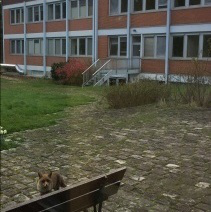Charlotte Kristjansen - The Gaudin matrix and AdS/CFT
Balázs Pozsgay - Integrable spin chains with medium range interactions
Eldad Bettelheim - Exact Matrix Elements of the Field Operator in the Thermodynamic Limit of the Lieb-Liniger Model
We study a matrix element of the field operator in the Lieb-Liniger model using the Bethe ansatz technique coupled with a functional approach to compute Slavnov determinants. We obtain the matrix element exactly in the thermodynamic limit for any coupling constant c, and compare our results to known semiclassics at the limit c → 0
Gregory Korchemsky - Symmetries of energy flow operators
Konstantin Zarembo - Integrable D-branes
Paul Ryan - Integrable deformations of AdS/CFT
The classification of integrable S-matrices in 1+1 dimensions boils down to classifying solutions of the Yang-Baxter equation. In this talk I will describe a highly efficient approach for obtaining all possible regular solutions using a novel method based on the boost operator of the corresponding integrable spin chain. The procedure is particularly useful for classifying deformations of low-dimensional examples of the AdS/CFT duality which are those based on the AdS2 x S2 x T6 and AdS3 x S3 x M4 backgrounds. The resulting families of deformations fall into two categories: functional and elliptic. I will discuss their physical properties and outline how the underlying symmetry algebras are modified which may provide hints on how to uplift the deformations to the associated string sigma models.
Zoltán Bajnok - Finite volume form factors
Dmytro Volin - Flags, fusion, ODE/IM and Bethe algebra
We introduce the notion of a fused flag and explain how it emerges in the context of ODE/IM correspondence. This concept is universal, and it offers new efficient ways to describe the algebra of conserved charges for integrable spin chains, solve TBA equations for sigma models and so on. Plücker coordinates of the flag form the extended set of Baxter Q-functions built from representations of Langlands dual of the symmetry algebra. Possibly, the described Q-functions are the SoV wave functions, this expectation is confirmed for gl(N) case.
Related topics: affine opers, [Miura] finite-difference opers, [twisted] affine Lie algebras, q-characters, QQ-systems
Based on works with P.Ryan, H.Shu, S.Ekhammar
Simon Ekhammar - SU(2|2) Quantum Spectral Curves from Monodromy Bootstrap
István Vona - Exact finite volume expectation values of conserved currents
Nicolò Primi - Boundary integrability for cusped Wilson Loops in N=4 SYM
A cusped Wilson line with J insertions of scalar fields at the cusp in N= 4 SYM forms an integrable system. I will show how it is possible to map such system to a quantum spin chain with open boundary conditions, and by applying integrability techniques such as the Baxter TQ-relation I will present the full, non-perturbative quantum spectrum for such observable.
Luke Corcoran - Combinatorial Solution of Non-diagonalisable Spin Chains
Nikolay Gromov
Part1: QSC for AdS3
Abstract: QSC is a powerful method of computing the non-perturbative planar spectrum. We conjecture the Quantum Spectral Curve equations for string theory on AdS3×S3×T4 with RR charge and its CFT2 dual. We show that in the large-length regime, under additional mild assumptions, the QSC reproduces the Asymptotic Bethe Ansatz equations for the massive sector of the theory, including the exact dressing phases found in the literature. The structure of the QSC shares many similarities with the previously known AdS5 and AdS4 cases, but contains a critical new feature - the branch cuts are no longer quadratic. Nevertheless, we show that much of the QSC analysis can be suitably generalised producing a self-consistent system of equations. While further tests are necessary, particularly outside the massive sector, the simplicity and self-consistency of our construction suggests the completeness of the QSC.
Part2: Bootstrability - new approach to correlation functions in AdS/CFT
Abstract: We study how the QSC in 4D N=4 Super-Yang-Mills can work efficiently together with the numerical conformal bootstrap techniques to go beyond the spectral observables and access previously unreachable quantities such as correlation functions at finite coupling. In the setup of 1D defect CFT living on a Maldacena-Wilson line, we managed to compute with good precision a non-supersymmetric structure constant for a wide range of the `t Hooft coupling. Our result is particularly precise at strong coupling and matches well with the recent analytic results of Meneghelli and Ferrero
Andrea Cavaglia - Separation of Variables in the fishnet CFT: the functional method
The strong deformation limit of N=4 SYM defining the fishnet CFT is a playground where the computation of QFT observables such as correlation functions is mapped rigorously to spin chain problems. The spin chain wave functions appear as crucial building blocks for correlators, indicating that the Separation of Variables (SoV) is a natural avenue to solve this planar CFT at finite coupling. I will present the first applications of SoV for quantities with nontrivial coupling dependence in the fishnet model, using the functional method - which reveals the form of some observables in separated variables even without the explicit construction of the SoV basis. The possible SoV structure of 1-point functions in presence of a defect will also be discussed. Finally, I will comment on the possibility to extend this approach to the parent theory N=4 SYM. The talk is based on work with N. Gromov and F. Levkovich-Maslyuk.
Shota Komatsu - Coulomb Branch and Large Charge

